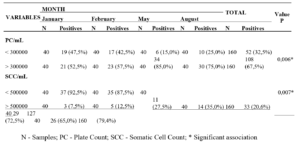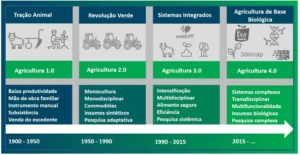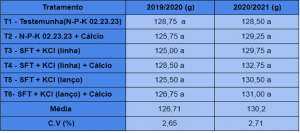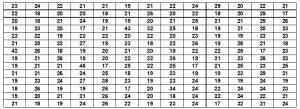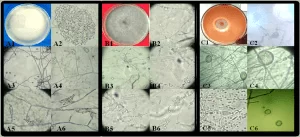ORIGINAL ARTICLE
SILVA, Jean Augusto Bueno da [1], JEZIORSKI, Cleiton Luís [2], MELLER, Júlio César [3], KREUTZ, Ivar José [4]
SILVA, Jean Augusto Bueno da. Et al. Social, environmental, technical and economic diagnosis of an agricultural production unit. Revista Científica Multidisciplinar Núcleo do Conhecimento. Year. 07, Ed. 02, Vol. 02, p. 54-77. February 2022. ISSN: 2448-0959, Access link: https://www.nucleodoconhecimento.com.br/agronomy-en/agricultural-production
ABSTRACT
Agribusiness has been developing more and more through techniques that maximize and facilitate the development of good agricultural practices, which generate good results. In this context, the problem studied during the research was: How do the technical, economic, social and environmental variables of the analyzed property help in the generation of income and subsistence? The present study aimed to analyze and diagnose the economic, technical, social and environmental aspects of a rural property, which is dedicated to grain production located in the municipality of Independência – RS, 2018/2019 crop year. To assist in obtaining and analyzing the data, qualitative and quantitative methods were used, as procedural methods, the case study and descriptive research were used. For the data collection technique, direct observation and unstructured interviews were used. To analyze the collected data, content analysis and statistical analysis were used to interpret the economic issues of the property and activities. As it was possible to verify, the main activity developed by the family is the production of grains, where the members of the same work in the activity, and the children of the couple intend to continue the activities that are developed there. However, it was found some points to be improved in the production system, such as: the introduction of a crop rotation and terracing plan, as well as the use of fertilizers according to the need established in the soil analysis, and some care in the protection of the environment. With regard to the economic part of the property, the production of grains presents a good income for the family, allowing future investment in the property. Therefore, it is concluded, based on the entire study above, that the property studied is viable, guaranteeing its sustainability, with an incentive to family succession.
Keywords: Agricultural unit, Diagnosis, Production Systems, Family Succession.
1. INTRODUCTION
Agribusiness has been developing more and more, with updated and appropriate techniques it is possible to maximize and facilitate the development of good agricultural practices, which lead to the production of good results. As a result, there is the generation of a good income for the producer, allowing the growth of the property and financial stability, factors that are fundamental for the success in an activity.
Therefore, several studies have been carried out in the area, with the objective of planning a more efficient agriculture, reducing possible aggressions to the cultivation means, such as soil degradation and water contamination, through the rational consumption of inputs, avoiding excessive use without effective results, thus resuming some soil conservation practices, ensuring that the most valuable asset of a producer is treated more correctly, always aiming at improving the physical and chemical conditions of the soil on his property.
In order to supply and compose the modernization that has been taking place in recent decades, in several areas of agriculture, more and more technologies are produced in inputs and machinery, which become essential in carrying out tasks and which, consequently, affect production and profitability.
Agricultural establishments have undergone several changes, and there has been a decrease in size in the last decade. The work developed in these small properties is usually done through family labor, which often refers to being examples of organization and management. Due to this, there is often a high investment related to state-of-the-art technology, making work in the field easier and more profitable, providing greater retention of people in the field.
According to Fernandes and Salamoni (2012), the diagnosis of agrarian systems provides a better understanding of the entire context in which the property is inserted, considering the environmental, social and economic aspects, as well as identifying its main characteristics. In a practical way, the diagnosis makes it possible to understand four main points which are: 1) the survey of the social, economic and environmental characteristics of the property in question; 2) identify the production systems and their management adopted by the owners and their main problems; 3) identify the main elements related to ecological, social, technical, cultural, economic and political issues that represent the reality being studied; and 4) suggest proposals for improvements in the points raised in the study that are in a critical situation and generating little return to the producer.
Thus, the diagnosis of the social, environmental, technical and economic aspects that involve all activities and the property as a whole is necessary, because it is through this survey that the owner will have a broader view of the points that need improvement and which can Continue. And, in this way, to increase the profitability of the property, through the use of alternative activities and/or crops, conservation of natural resources, use of agrochemicals according to the needs of crops and soil, in addition to promoting the conservation of water resources available, reflecting on the improvement of the quality of life of the owner and his family, who reside in this place and earn their livelihood from it, encouraging future generations to continue in the activity.
Therefore, the study in question aimed to point out necessary improvements not only for production but also for the organizational system of a rural property of 200 hectares in the municipality of Independência, located in the Northwest region of the State of Rio Grande do Sul, observing the social aspects , economic, technical and environmental, aiming to find alternatives that improve the results, and guarantee a better quality of life and the constant preservation of the environment.
In this context, the problem studied during the research was: How do the technical, economic, social and environmental variables of the analyzed property help in the generation of income and subsistence? The present study aimed to analyze and diagnose the economic, technical, social and environmental aspects of a rural property, which is dedicated to grain production located in the municipality of Independência – RS, 2018/2019 crop year.
2. METHODOLOGICAL ASPECTS
The present study aims to diagnose the various variables involved in the primary production process of a rural property located in the municipality of Independência – RS, considering the technical, social, economic and environmental aspects, in the first half of 2019.
The problem studied during the research was: How do the technical, economic, social and environmental variables of the analyzed property help to generate income and subsistence?
In order to solve this problem, the following hypotheses were pointed out: The slope of the plots is related to the installed cultivation. The indicators show high fertility levels for the respective plots. The physical indicators of soil density, resistance to penetration and infiltration, are at adequate levels for the cultures practiced. The cultivated areas of the property under study have conservationist practices that allow an efficient erosion control. The P and K indices were at high levels, providing a good development of the cultures practiced. The activities carried out on the property, in its cultivation diversity, generate positive results in terms of profitability. The producer and his family have an active and harmonious interaction with the community where they live. In the property under study, there is a prospect of family succession.
The quantitative approach method was used for questions related to the economic part of the property, such as: improvements, revenues, production cost, feasibility of each activity, planialtimetric survey of the site, soil penetrometer. The qualitative method, on the other hand, was used to evaluate the family’s social relationship with: the external environment, the community in which they are inserted, their coexistence with cooperatives and the rural environment, all machinery, properties, existing equipment, and environmental aspects that govern it, in addition to the future perspective for the property, mainly aiming at family succession.
The procedural methods used were: the case study method, to collect the history of the property, being the recipes and, the descriptive research, to describe all the information collected about the property under study to carry out the diagnosis.
As data collection techniques, the intensive direct observation technique was used to analyze the aspects that guide the social, environmental, technical and economic factors analyzed. And, the interview technique was applied in this study in a non-standardized and non-directed way, in order to provide the interviewer with freedom in conducting the research, directing it as he deems appropriate. The interview technique was applied in the study to collect relevant data about the rural property together with the owner and administrator of the activities carried out on it.
The content analysis technique was also applied to evaluate the processes involved in the production system of the property and also to analyze the bibliography consulted during the development of this article. In addition, statistics were used with the use of calculations for the economic evaluation of the property.
3. THEORETICAL REFERENCE
Rural properties are part of the society in which they are inserted, therefore, they are responsible for meeting social and labor obligations and observing the impact they have on human well-being, the environment and society. In this way, they will generate financial resources, provide benefits to their environment and meet market demands that seek a final product with quality and safety, resulting from competitive, environmentally correct and socially fair production chains (VALLE, 2007).
According to Tesche (2007), social relations in rural areas can be classified into two: external and internal. The external ones are the participation and involvement in cooperatives and associations, and the internal ones, through the relationship between people in the family circle.
Family farming consists of using the labor of the family itself, which is responsible for generating income, being the same, manager of the property, not having an area larger than 4 fiscal modules, without using salaried labor from third parties, being responsible for the great part of the food produced, mainly, for the fact of producing and consuming, having a minimum income through the activities developed in the property (ANDRIOLI et al., 2009).
According to Brandão (2015), family succession still needs major observations to be carried out, mainly due to the sequence of an activity that often ends up not being of interest, in addition of course, they are often conservative companies, without technology and outdated, becoming unable to update. Therefore, they are at risk of having their growth compromised. Therefore, there is a need for investment and demonstration that it is possible to always improve in all activities, because even in agriculture, there is an increasingly globalized and competitive scenario, losing space for low incomes and little use of technology.
Soil fertility management depends on correct sampling and an accredited laboratory to perform chemical and physical analysis. The diagnosis of the results obtained by the soil analysis will allow the execution of a fertilization planning, taking into account the species that will be cultivated. To measure the fertility of a soil, the analysis carried out by the laboratory must contain the results of clay content, pH in water, amount of available nutrients, undesirable elements toxic to plants, thus carrying out the correction recommendations (TROEH; THOMPSON , 2007).
The corn crop for Rio Grande do Sul has significant socioeconomic importance, occupying approximately 15% of the total areas sown with spring-summer crops, adding the areas destined for grain production and silage. This socio-economic importance is evident in the culture of corn, because it is a fundamental raw material for the production chains of poultry, swine and milk (62 MEETING OF RESEARCH OF CORN AND SORGO DA REGIÃO SUL, 2017).
In relation to soybean, Brazil stands out as the second largest producer in the world, behind the United States. In 2015/2016, Brazilian soybean production corresponded to 30% of world production, with Mato Grosso being the largest producer state in Brazil, with 26.058 million tons, followed by the States of Paraná with 17.102 million tons and Rio Grande do Sul with 16.201 million tons (GARCIA, 2017).
The national production of wheat is concentrated in the southern region of Brazil and corresponds to 90% of the national production. The yield of this cereal has increased significantly in the last 50 years, as a result of the efforts of genetic improvement programs. In the 1960s, production was 771 kg ha-1 year, while in 2015, annual production was 2,382 kg ha-1. (BONA; MORI; WIETHÖLTER, 2016).
Within a rural property, in addition to activities developed for commercial purposes, there are also subsistence activities, which are characterized by low production and the use of low-tech resources. Among the subsistence activities, the production of beans, cassava, vegetables, fish farming, beekeeping, beef cattle, swine, poultry and orchard for fruit production stand out (SANTIAGO, 2011).
In view of the above facts, it is still emphasized that environmental legislation in a rural property is extremely important, since all the activities carried out collaborate directly and indirectly in the sustainability of the agricultural unit (KLEIN; ROSA, 2011).
Finally, to economically evaluate a rural property, it is necessary to collect all possible financial data where, for Silva (2005, p. 6), “the statement reports the history of the activity during a fiscal year or for shorter periods, which can be, for example, a quarter or a semester”.
4. RESULTS PRESENTATION
The history of the researched production unit began when Jorge Meller and Conceição Meller got married on May 20, 1946 and went to live in the town of Esquina Neves, in the countryside of the municipality of Catuípe, about 10 km away from where the current headquarters are located.
Currently, the decisions made on the property are made by your children. The property has 3 own areas and 3 leased areas, focused on the production of soybeans, corn and wheat, in addition to sheep, which are the family’s hobby, and other subsistence crops.
Owners participate in the social relationship between the family, where work is only family work. In addition to having Mr. Darci manage the property, decisions are taken together, since everyone is involved in the production process, with a good relationship between the brothers and their spouses.
Whenever possible, they participate in field days, lectures or courses related to activities developed to improve knowledge and seek new technologies. Where, according to Carmo and Colognese (2010), participation in these events promoted by entities and institutions linked to rural areas help producers to improve the activities that are developed, as well as demonstrate new and more effective cultivation techniques, which will reflect on the increase in the productivity of the activities that are being presented there.
The owners of the property under study think about a possible succession of activities to the son Jair, of Maria one of the owners, who is 47 years old, has a quality management course, has experience with heavy mechanics, maintains the property’s machinery and participates in the production processes, effectively helping with the work of the property, showing interest in succeeding activities.
In addition, Abílio’s son, at the moment, is not helping in the production process of the property. However, he is studying a degree in agronomy to, in the future, through the knowledge obtained, contribute even more to the quality of the processes that involve the production of the property.
These, then, will work together for the evolution of the processes of the property, being that all involved are aware of the same, and have reached an agreement on how this process should take place.
The property consists of 6 plots, 3 of which are owned, which are delimited by Gleba Sede, Tapera and Air. The Pedro, Luiza and Lanzanova plots are leased.
The headquarters of the property is located in the community of Colônia Glória, municipality of Independência, 3 km away from the community of Esquina Araújo. The headquarters plot has a total area of 64.5 hectares, of which 1 hectare is occupied by the property’s facilities, containing sheds, houses, subsistence cultivation area and animal husbandry, as can be seen in Figure 01.
Figure 01 – Property Headquarters
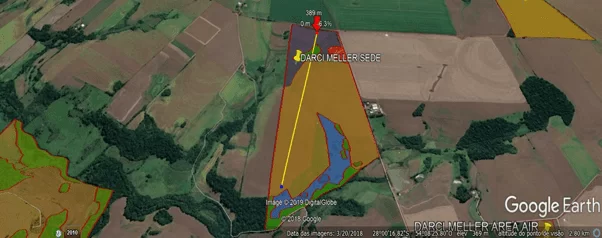
On this plot, animals are raised for subsistence, for which there is native grass pasture, occupying an area of 9.8 hectares that are destined for cattle feeding, located at the back of the property area. Next to the headquarters, there are pasture areas with stoloniferous grass, which is used for grazing sheep. Wheat is cultivated in the head office area in the winter, in this area 8 hectares of corn were cultivated in the summer, and the rest of the 50 hectares with soybeans. There are terraces in the area, sowing is done at level and only succession of crops.
The Lanzanova tract comprises a total area of 24.7 hectares, with a cultivated area of 20.5 hectares. This area is located about 1.5 km from the headquarters area, leased by the family since 2016. Figure 02 shows the Lanzanova plot.
Figure 02 – Gleba Lanzanova
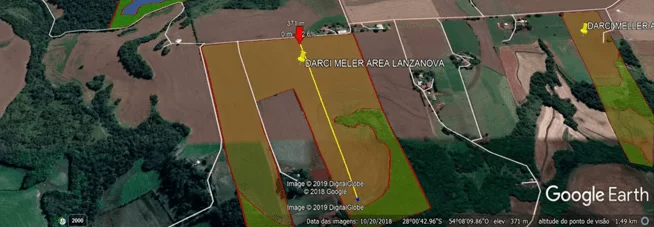
On this plot, the succession of soybean and wheat crops is used, as it was concluded that the use of crop rotation was not feasible and, as they are some of the main grain commodities, their sale is facilitated. There is no use of terraces in the area, in addition, sowing is used according to the terrain. The native forest is not used by the tenants. In this plot, the amount of forest corresponds to about 17% of the total area.
The amount paid for the lease of this area corresponds to 17 bags of soybeans per hectare of cultivation, totaling 340 bags of soybeans. The average slope of this area is 5.2%, being considered an area with little slope and easy cultivation, with regard to agricultural mechanization.
In the 2018 wheat crop, a yield of 45 bags of wheat pH 78 per hectare was obtained, totaling 922 bags of wheat in the total area. In the 2018/2019 summer crop, soybeans were grown on this plot, obtaining an average productivity of 58 bags of soybeans per hectare, totaling a production of 1,189 bags of soybeans in this area.
The land called Luiza is located in the municipality of Giruá and is located 8 km from the headquarters area, comprising a total area of 75.5 hectares, with 55 hectares of cultivation, in which sowing is carried out according to the terrain. This difference in the cultivated area shows that 27% of the land is not cultivated, as there is a forest.
Figure 03 – Gleba Luiza

In this area, the producer uses the succession of crops with soy and wheat, this has been leased since 2009, in which, as a matter of decision of the owners, the producer will deliver the area after the cultivation of wheat crop 2019. In this area there are no terraces, only sowing is used according to the levels of the land, being harmful to the area.
As a form of lease, Mr. Darci, pays 15 bags of soy per hectare of cultivation in this area, making a total amount of 750 bags of soy each year. The slope of this area varies from 1.4% to 20%, but the average is around 7.1%, which does not hinder the activity of agricultural machinery.
In this area, wheat was cultivated in the 2018 crop, obtaining a productivity of 32 bags of Ph 78 wheat per hectare, resulting in a total production of 1760 bags of wheat. In the 2018/2019 summer crop, soybeans were grown and a productivity of 48 bags per hectare was obtained, making a total production of 2640 bags of soybeans.
The land called Tapera is located 2 kilometers from the property’s headquarters, it comprises 27 hectares of total area and the cultivation is for the family itself. It has a slope that varies from 1 to 16%, with an average of around 6%, but this does not hinder the performance of agricultural machines at all.
This area is defined by Mr. Darci with the best plot of land in terms of ease of performance of agricultural machines. It can be seen in figure 04
Figure 04 – Gleba Tapera
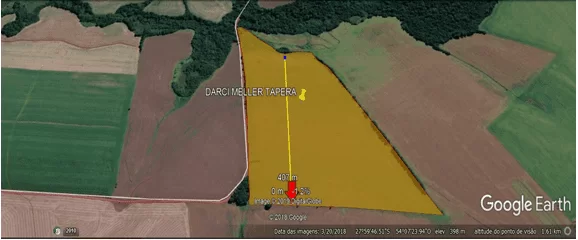
Regarding the crops carried out in this area, in the 2018 winter crop, wheat was cultivated, obtaining a productivity of 40 bags per hectare, totaling 1080 bags of wheat with pH 78. In the 2018/2019 summer crop, soybeans were cultivated in this area, with a yield of 54 bags of soybeans per hectare, with a total of 1458 bags of soybeans. There is terracing in the area, which requires maintenance, because if there is a high volume of rainfall, soil erosion can occur, therefore, level sowing is used.
The land called Air is located 2.1 kilometers from the headquarters area. This was acquired in 2018 and has a total area of 7 hectares, 2.1 of which are cultivated areas, with 30% of native forest.
Figure 05 – Gleba Air
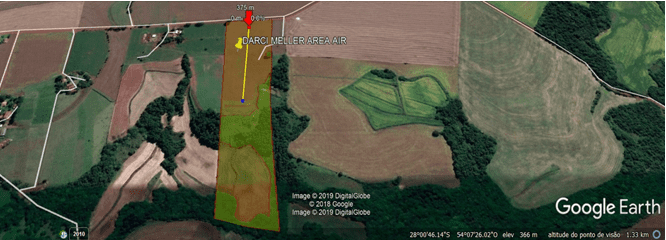
This area has a slope that varies from 2.0 to 8.8%, with an average of 7.2%. Regarding the crops, in the winter crop of 2018 it was left fallow, because as this area was acquired recently, the owners decided to leave it fallow to carry out some improvements. There are no terraces in the area, the producer sows level and uses the direct sowing system. In the summer crop, soybean was cultivated, obtaining a productivity of 43 bags per hectare. Seu Darci reported that this low productivity can be attributed to the low fertility of this area, as the former owners did not fertilize as needed.
The Pedro area is located 10 kilometers from the headquarters. It is a leased area, in which there are 15.5 hectares of cultivation, which the producer rents for 230 bags of soybeans, 15 bags per hectare of cultivation. There is no presence of terraces in the area, only level seeding is practiced in the direct seeding system, as seen in figure 06.
Figure 06 – Gleba Pedro
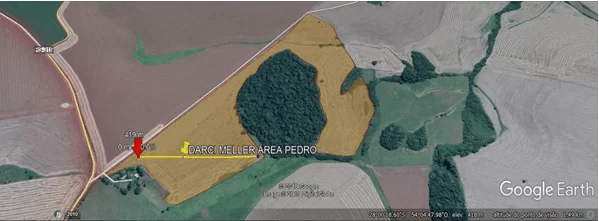
This area has an average slope of 5.4%, being considered an area of easy management. In it, the succession of crops with wheat and soybeans is carried out. In the winter of 2018, wheat was grown, and in the summer of 2018/2019, soybeans were grown.
As can be seen, the plots of the property do not have a soil conservation system, which makes it impossible to improve physical, chemical and biological conditions, as well as the infiltration of water into the soil. Thus, terracing is a conservationist practice that, according to Cunha et al. (2011), allows greater infiltration of water into the soil and disciplines the flow of these to a drainage stream. However, this must be associated with other methods, such as crop rotation, so that there is a greater contribution of straw to the soil, which will contribute to increasing the levels of organic matter and soil porosity. In this way, landowners must start to make use of these techniques so that there is an improvement in soil quality and, consequently, in crop productivity.
Table 01 presents the interpretations of the results of the soil analysis in general.
Table 15 – Interpretation of soil analyzes
| Prof. Col. | Sample | Land | Area(Ha) | M. O. | P | K | Ca | Mg | pH H2O |
| 0-10 cm | 44217 | Sede | 50 | High | M. High | High | High | High | 6 |
| 10-20 cm | 44218 | Sede | 50 | Medium | Low | Low | High | High | 5,7 |
| 0-10 cm | 44208 | Lanzanova | 20,5 | High | M. High | High | High | High | 5,4 |
| 10-20 cm | 44209 | Lanzanova | 20,5 | Medium | Medium | Low | High | High | 5,6 |
| 0-10 cm | 44205 | Luiza | 55 | High | Medium | High | High | High | 5,4 |
| 10-20 cm | 44206 | Luiza | 55 | Medium | Low | Low | High | High | 5,7 |
| 0-10 cm | 44211 | Tapera | 27 | High | M. High | Medium | High | High | 5,9 |
| 10-20 cm | 44212 | Tapera | 27 | High | High | Medium | High | High | 5,9 |
| 0-10 cm | 44214 | Air | 7 | High | M. High | M. High | High | High | 6,4 |
| 10-20 cm | 44215 | Air | 7 | Medium | Low | M. High | High | High | 6,2 |
| 0-10 cm | 44202 | Pedro | 15,5 | High | High | Low | High | High | 5,3 |
| 10-20 cm | 44203 | Pedro | 15,5 | Medium | High | Low | High | High | 5,1 |
| 0-10 cm | 44199 | Pastagem | 9,8 | High | Low | Medium | High | High | 5,6 |
| 10-20 cm | 44200 | Pastagem | 9,8 | Medium | M. Low | Low | High | High | 5,8 |
Source: Kreutz; Jeziorski; Silva; Meller (2019)
Comparing the clay content present in the soil, the plots fit into textural class 1, presenting a clay content greater than 60%. In the liming recommendation procedure, some criteria that assess soil pH and CEC saturation by aluminum must be taken into account. Among the plots analyzed, the pasture presented a very high pH index and, in the Lanzanova plots, the pH content is at a low level.
To make a liming recommendation, the pH and the percentage of base saturation are analyzed. The amount of concealer to be applied depends on the pH in the water. The amount applied will result in a decrease in the potential acidity of the soil, which is expressed by the SMP index. As SMP increases, soil acidity decreases. To estimate how much limestone will be used, it is important to observe the PRNT percentage (Relative Power of Total Neutralization), so that the amount of this buffer is correct.
The cation exchange capacity and the contents considered average, which are between (7.6 – 15.0), fit the studied areas. When analyzing aluminum saturation, it is observed that Lanzanova 2 has a low content, between (1 – 10%). Analyzing the base saturation, the two Lanzanova tracts fall within the low content (45% – 64%) and the Pastagem tract has the high content (75% – 80%).
The pH levels of the Pedro tract at the two depths collected, 0-10 and 10-20 cm, are considered acidic, as they present a high level of Aluminum, 0.8 and 2.5 respectively, in addition to the saturation of bases be 43.8 and 28.1, indicating that liming will be necessary to correct the soil acidity level.
Organic matter is essential for calculating the amount of nitrogen in the fertilization, and it also helps to maintain the structure, thus providing a greater N contribution to the successor crops. It was verified that the studied plots presented M.O. content between medium to high, where the Air plot had the lowest of the values found, 2.5% of M.O., and the Sede and Luiza plots had the highest levels of organic matter, which was 3.6% at 0-10 cm depth for both.
When interpreting the phosphorus content, it is necessary to know the clay and P content. Considering the studied plots, the average levels (6.1 – 9.0) were obtained for Lanzanova 1 and Pastagem, and level high (9.1 – 12.0) at Lanzanova 2. To do so, potassium is interpreted through CEC levels, at the same time it is also necessary to know the content of K contained in the soil. The results obtained through soil analysis indicate a very high level for the Lanzanova tracts and average content for the Pastagem tract.
According to Broch and Ranno (2012), the interpretation of the necessary levels of liming and fertilization are practices of great importance in contributing to the increase in crop productivity. Thus, the recommendation of fertilization and liming for soil analysis occurs through the interpretation of the levels of nutrients present in it, thus determining the amount of corrective and fertilizers necessary to achieve the desired productivity of the crop to be implanted.
According to the owners’ report, there are few products purchased to feed the residents, due to food production taking place within the property, where vegetable crops, cassava, fruits and meat are grown. All this production corresponds to the amount of R$ 13,441.50 that is not spent on food purchases.
The highest values for the purchase of vegetables, if they were purchased, in relation to vegetables, cassava, corresponds to R$ 440.00 and tomatoes R$ 210.00, while for fruits, pitanga with R$ 375, 00 and the pecan nut with R$ 375.00. Animal derivatives have the highest added value, compared to other products produced on the property, where beef corresponds to the highest annual cost with R$ 4,140.00, in addition to sheep meat with R$ 3,480.00.
The great diversity of existing crops on the property was verified, always carrying out abundant harvests of the crops, valuing quality, since it is offered to family members and not commercialized.
The subsistence activity, as highlighted by Grisa and Schneider (2014), provides greater food security and resource savings. Thus, many rural properties develop this activity, which represents an autonomy of the owners to produce products with higher quality and with less developed resources.
This property, in question, contemplates soil conservation, with level terracing in two plots, which has the purpose of preventing water from flowing with greater speed over the soil, causing erosion. However, the damage caused by excessive rains is visible, where there are surface runoffs in the other plots, demonstrating the need to implement more terraces on the property.
In the plots that contain the contour lines, it is possible to visualize superficial erosions, because they do not have the proper maintenance provided for by conservation practices and because they are in a crop succession of crops Wheat/Soybean, where there is not the appropriate rotation and amount of straw necessary for efficient soil cover.
As for the fuel supply of the property’s machinery, it is carried out next to the shed in a metal tank. The oils used to lubricate some equipment, chainsaws and seeder chains are placed in a vat to avoid polluting the soil. Regarding the filters, the producer only decants the oil and stores them in a box, so that when the selective collection is carried out by the municipal government, this material is delivered.
As for the permanent preservation areas, in the Headquarters area they are not consolidated, as there are no boundaries that prevent the entry of animals, which are used for subsistence, on the property. In addition to this, the other plots have areas of native vegetation which the producer does not use for any purpose.
Regarding animal waste, these are collected and spread in the garden area, as a source of organic fertilizer. And, in relation to the water used for spraying and for supplying the sprayer, the producer uses water from a source on the property, pumping it from this source. For applications in areas far from the headquarters, a 4,000 L tank is used, which is transported in the truck and is used to store the water needed for spraying.
The property does not have a specific space for storing pesticides and empty containers. These are stored in a corner of the shed, without separating the products by purpose or separating the packages already used and that must be returned. This increases the chances of cross-contamination between products.
However, Souza and Palladini (2005) emphasize that producers must be careful when storing pesticide containers, whether full or empty, so that soil contamination does not occur. And they must be disposed of properly after use, carrying out the triple washing, having the bottom perforated and storage carried out properly.
The property’s own areas are registered in the CAR (Rural Environmental Registry) and comply with the law, as they are areas smaller than 4 fiscal modules, according to each successor. According to Law No. 12,651 (BRASIL, 2012), registration in the CAR is the first step to obtain the environmental regularity of the property, which must include the owner’s data, data proving ownership, information on the size of the area , remnants of native vegetation, permanent preservation areas, consolidated areas and legal reserve. With this document, the producer has access to available public policies, as well as regularizing the lack of a permanent preservation area on the property.
From the beginning, agricultural production should go hand in hand with the environment, cultivating without harming it, taking care of its resources and preserving them. The soil we cultivate is the greatest asset of the rural producer, which many times ends up being left aside to facilitate its cultivation.
The balance sheet of the property was carried out with the aim of raising the economic data of this, so that after analyzing these data, it is possible to make important decisions for the conduct of the property, being able to define its future, as well as enabling the calculation of some indicators that will give an overview of the financial situation of the property’s main business, which is the cultivation of soybeans, corn and wheat. Figure 08 shows the property’s balance sheet.
The balance sheet, according to Gitman (2010), offers a statement of the financial results of the rural property considering all its income, variable and fixed expenses and its equity, resulting in the net result of the analyzed period.
Figure 08 – Balance sheet
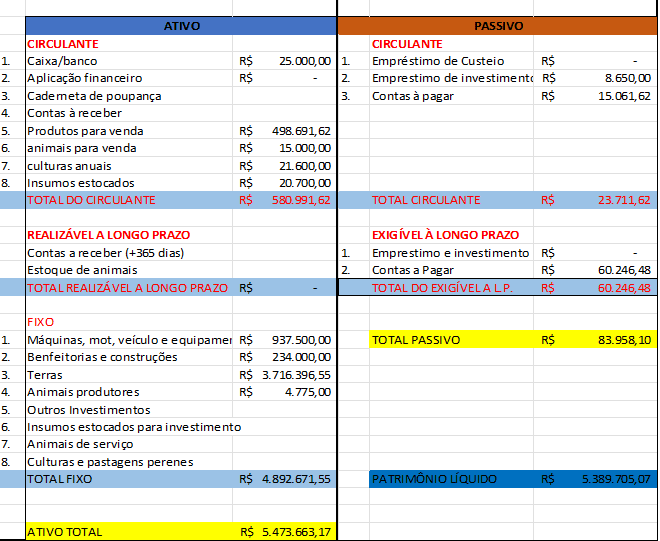
Based on the balance sheet data, it was possible to conclude that the Indebtedness Degree of the property is 1.53%, which means that for every R$ 100.00 that the property has in equity, there is a debt of R$ 1.53 . This index is considered very good.
As seen, the cultivation of grains on the property is the main activity and source of income. The total costs of each culture are formed by the fixed costs added to the variable costs of each culture, as shown in Figure 09.
Figura 09 – Custos totais das culturas

Analyzing Figure 09, it can be concluded that the crop that had the highest total cost was corn, with a value of R$ 2,518.44 per hectare, followed by wheat, with a value of R$ 2,161.66 and, the crop that presented the lowest total cost was soybean, with a total cost of R$2,081.45.
Gross margin refers to the gross revenue of each crop, less total costs. As shown in Figure 10, we can see that the soybean crop has the highest gross margin among the crops that are implemented on the property, reaching 46% in the 2018/2019 harvest, that is, for every R$ 100.00 invested there was a return of R$ 146.00.
The corn crop in the 2018/2019 crop had a gross margin of 24%, that is, for every BRL 100.00 invested there was a return of BRL 124.00. The wheat crop, in the 2018 harvest, had a negative gross margin of -47%, with every BRL 100.00 invested returning only BRL 53.00.
Figure 10 – Gross margin of cultures

Through the economic analysis of sheep farming, it was found that the activity does not prove to be advantageous, as it does not have a positive result in production, but a negative one, which in the economic analysis refers to the exclusion of the activity and, possibly, refers to the replacement for the cultivation of grains that has significant production results, in addition to dedicating itself to the production of only one system.
5. CONCLUSION
According to the activities carried out on the property, together with the data collection carried out with the owner-partners, taking into account the hypotheses and the problem, some considerations could be obtained.
As for the hypothesis that refers to the indicators of high soil fertility, this was not confirmed due to the low soil fertility of the analyzed plots, as they have acidic pH and high levels of aluminum, thus bringing limitations of productivity by acidity and Al intoxication.
Considering one of the biggest reasons for soil degradation, causing the loss of nutrients and, above all, an imbalance in the soil structure, water erosion, must be taken seriously, because with it the straw and the soil solution containing vital nutrients for the full development of crops are carried by the water. For this reason, the hypothesis that there would be a soil conservation practice on the property is not confirmed, as this occurs in only two plots using the contour line method and, even in these areas, it is easy to see the lack of maintenance of the terraces, because there is surface runoff in the plots. The rest of the areas do not have any type of containment and crop rotation, the cultivation carried out on the property is a succession of Wheat/Soybean crops and a small area of corn for subsistence.
As for the hypothesis of phosphorus and potassium nutrient levels analyzed through the interpretation of soil analysis, it was concluded that they vary according to the plots. So, it was possible to evaluate the Lanzanova plots, which have a high level of the nutrient K, while the pasture plot has a medium level. When compared to P levels, the Lanzanova 1 and pasture plots have a high level and, the lanzanova 2, reaches the medium level, confirming the hypothesis in question, that the availability of nutrients favors the development of the culture helping to increase the productivity.
The property mostly develops the cultivation of grains and, in detail, subsistence. One of the hypotheses was about the activities developed on the property, in its cultivation diversity. According to the calculations made, these generate positive results in terms of profitability, because despite having negative numbers in the 2018/19 wheat crop, other grains, such as soybeans and corn, showed good numbers, showing that there really is liquidity in the accounts, in addition to covering the costs of sheep production on the property.
The family group participates, through the church and the community in which it is inserted, in events that take place in the locality, in addition to having a good relationship of friendship with the other members, as well as with the owners of the local businesses with whom they do business of the property and its individuals, then, the hypothesis of having an external relationship with the community in which it is inserted is confirmed.
The hypothesis regarding the future family succession of the activities of the property is confirmed as exposed, because it is hoped that Maria’s son, who already works on the property, and Abílio’s son, who seeks resolution from the owners, return to the property after complete graduation.
Regarding the women who live there, the division of labor is based on the cultivation of the vegetable garden, to have basic food in their daily lives, and household chores. Men are responsible for providing services related to the cultivation of grains and handling of animals for subsistence, cleaning and organization of agricultural machinery.
Returning to the research problem: “How do the technical, economic, social and environmental variables of the analyzed property help to generate income and subsistence?” Among the information collected to answer this problem, it became necessary to analyze the items described in the diagnosis of the property and, based on this information, it can be confirmed that this property meets the technical, economic, social and environmental requirements, providing the opportunity to generate income to the family while maintaining opportunities for leisure and participation with society.
Therefore, it is concluded that, based on the entire study above, the property studied is viable, ensuring sustainability, with incentives for family succession.
REFERENCES
ANDRIOLI, Antônio Inácio (org.). Tecnologia e agricultura familiar: uma relação de educação. Ijuí. Ed. Unijuí. 2009. ISBN 9788574298528.
BONA, Fabiano Daniel de; Mori, Cláudia de; WIETHÖLTER, Sirio. Manejo nutricional da cultura do trigo. Informações agronômicas nº 154. International plant nutrition institute-Brasil. 2016. ISSN 23115904.
BRANDÃO, Thales. Sucessão familiar. [Online]. 2015. Disponível em <http://www.ibe.edu.br/sucessao-familiar/>. Acessado em 09 mar. 2019.
BRASIL. 2012. Lei nº 12.651, de 25 de maio de 2012. Dispõe sobre a proteção da vegetação nativa; altera as Leis nº 6.938, de 31 de agosto de 1981, 9.393, de 19 de dezembro de 1996, e 11.428, de 22 dezembro de 2006; revoga as Leis nºs 4.771, de 15 de setembro de 1965, e 7.754, de 14 abril de 1989, e a Medida Provisória nº 2.166-67, 24 de agosto de 2001; e dá outras providências. Brasília: DF: Diário Oficial da União, p. 1, 28/05. Seção 1.
BROCH, Dirceu Luiz; RANNO, Sidnei Kuster. Fertilidade do Solo, Adubação e Nutrição da Cultura da Soja. Tecnologia e Produção: Soja e Milho 2011/2012. Maracaju: Fundação MS. 2012.
CARMO, Raquel Mendes do; COLOGNESE, Silvio. Qualificação e permanência do agricultor familiar no campo: a casa familiar rural do município de Candói – PR. Revista Eletrônica Multidisciplinar. V. 1. N. 1. Pitanga: UCP. 2010.
CUNHA, Fernando França da; LEAL, Aguinaldo José Freitas; ROQUE, Cassiano Garcia.. Planejamento de sistemas de terraceamento utilizando o software Terraço 3.0. Brazilian Geographical Journal: Geosciences and Humanities research medium, v. 2, n. 1. Uberlândia: UFU. Jan/Jun. p. 182-196, 2011.
FERNANDES, S.; SALAMONI, G. Proposta metodológica para diagnóstico socioeconômico e ambiental: uma abordagem sistêmica e integrada do espaço agrário. In: Anais do XXI Encontro Nacional de Geografia Agrária, MG: UFU, 2012.
GARCIA, Rodrigo Arroyo. Diversificação do sistema produtivo: estratégia para superar entraves da sucessão de culturas. Revista A granja. [Online]. 2017. Disponível em <https://www.embrapa.br/busca-de-noticias/-/noticia/14364329/artigo—diversificacao-do-sistema-produtivo-estrategia-para-superar-entraves-da-sucessao-de-culturas>. Acessado e 30 mar. 2019.
GITMAN, Lawrence. 2010. Princípios de administração financeira. 12. Ed., São Paulo: Pearson.
GRISA, Catia; SCHNEIDER, Sergio. Três gerações de políticas públicas para a agricultura familiar e formas de interação entre sociedade e estado no Brasil. Revista de Economia e Sociologia Rural. v. 52. Suppl. Piracicaba: SOBER Fev. pp. 125-146. 2014.
KLEIN, Marcelo A; ROSA Marcelo B. Adequação de propriedades de agricultores familiares à legislação ambiental: a educação ambiental como mitigadora do processo. Santa Maria, RS: UFSM. 2011.
REUNIÃO TÉCNICA ANUAL DO MILHO, 62º; REUNIÃO TÉCNICA ANUAL DO SORGO, 45º. Indicações técnicas para o cultivo de milho e de sorgo no Rio Grande do Sul: safras 2017/2018 e 2018/2019. Pelotas: Embrapa clima temperado. 2017.
SANTIAGO, Emerson.Agricultura de subsistência. Brasil Info Escola. 2011.
SILVA, Edson Cordeiro da. Como administrar o fluxo de caixa das empresas. São Paulo: Atlas. 2005.
SOUZA, Reginaldo Teodoro de; PALLADINI, Luiz Antonio. Sistema de produção de uva de mesa do Norte de Minas Gerais. Sistema de Produção 11. Bento Gonçalves: Embrapa Uva e Vinho. 2005.
TESCHE, Rubens Wladimir; MACHADO, João Armando Dessimon. As Relações de Reciprocidade e Redes de Cooperação no Desempenho Socioeconômico da Agricultura Familiar. Emater/RS-Ascar. 2007.
THOEH, Frederick, R; THOMPSON, Louis, M. Solos e fertilidade do solo. 5 Ed São Paulo. 2007.
VALLE, Ezequiel Rodrigues. (Coord.). Boas práticas agropecuárias: Bovinos de corte. Campo Grande: Embrapa Gado de Corte. 84 p. 2007. ISBN 85-297-0203-4.
[1] Bachelor in Agronomy. ORCID: 0000-0002-6849-2174.
[2] Bachelor in Agronomy. ORCID: 0000-0002-2493-0208.
[3] Bachelor in Agronomy. ORCID: 0000-0003-0064-1978.
[4] Advisor.
Sent: November, 2021.
Approved: February, 2022.

